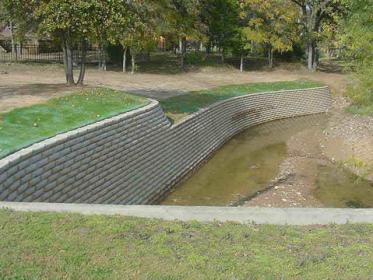Some of this depends on where you live, and what the surrounding soil/material is.
We are in southern California where it rains hard from time to time, and it would be prohibitive to try to edge with grass- it would bankrupt you trying to keep it green. We have two rows of RR ties- one row installed in the early days ended up not being enough so we added the second row on top of the first- and it works well. This is a court-style arena without fencing so it’s just the rr Ties.
There is only one tie in the two entrances (half the height of the rest of the arena) so the tractor can drive in and out and they do offer some drainage, but we built two significant drains into the lower (engineered lower on purpose) corners of the arena. They are 4" PVC underground pipes that lead to gravel plus landscaped spreading areas outside the arena in one corner and the other leads to the rest of our drain system. The drains are right next to the ties and about 4" below the arena surface. When It rains/is forecast ( pretty predictable in California, it is not a frequent thing) we use a ditch shovel, dig straight down next to the ties where we know the drains are, reveal the drain cap (PVC also, with a ‘leash’ on them) and just pull the caps off.
It is AMAZING how much water can runoff an arena when we get a heavy storm. Sometimes we get some backup around the drain which can create a little eroded basin, but we just fill it in/repair it after a storm. The arena in questions is rectangular, and the drains are in the way-corners almost underneath the RR ties, so if the area around the drain gets disturbed, it’s not an area where horses can really even put a foot down.
We also ‘seal’ our arenas before it rains, which for us is to drag them lightly then drive over them with a giant lawn roller that compresses the footing. Sealing them seems to save a day or two in being able to use them again, and it sure helps keep the footing material in place. When sealed, water sheets off the arena and heads for the low spots/drains and the water doesn’t seem to drag material with it, the rain just further compresses the footing material (sand in our case) into a harder surface that the water gets off of without penetrating so much.
The RR tie permitter takes a little care for drainage, but the RR ties overall have performed really well. They are drilled and staked down about every 4’ with 24" of 3/8" rebar. The ties are also strong enough that if they get bumped with the tractor drag, it just bounces off.
On another arena, we have 2 x 8" sand rails/footing boards/retainer boards made out of pressure-treated, painted lumber. We still have to trench under them for the water to get off the arena for heavy storms, and they need scraping and paining every couple years. They will also bow eventually from the footing pushing against them (steel posts support these rails about every 8’) and will break when they get old if you smack them with the drag.
Both systems are some work, but both do the job, mostly because our ranch helpers are fabulous shade tree engineers and always on the ball to prep for rain. The drain/sealing prep is better than driving home and seeing all your footing going down the street!
There are a lot of ways to retain footing- see what others in your area like and don’t like about their systems and you’re likely to come up with something great!

